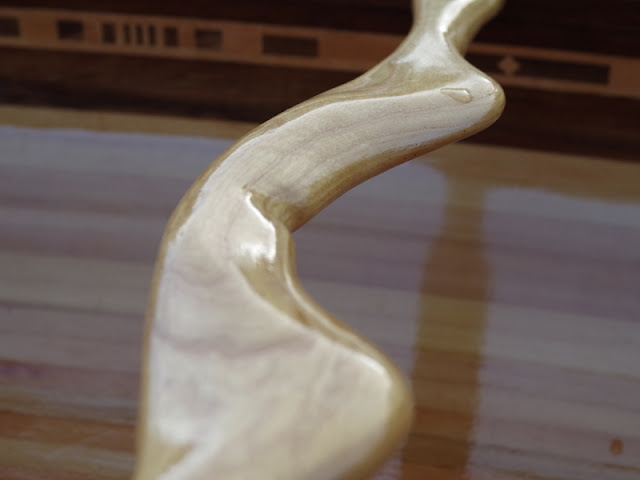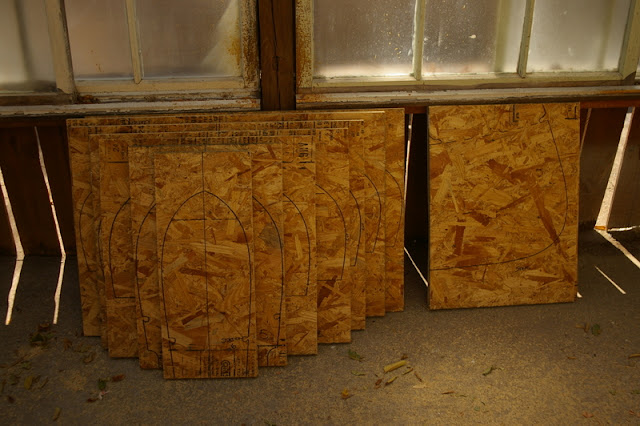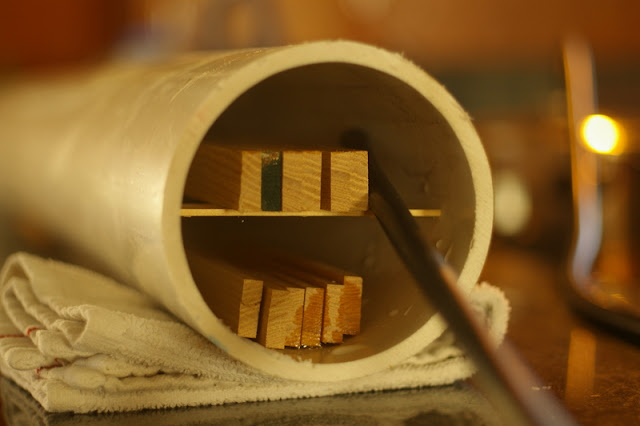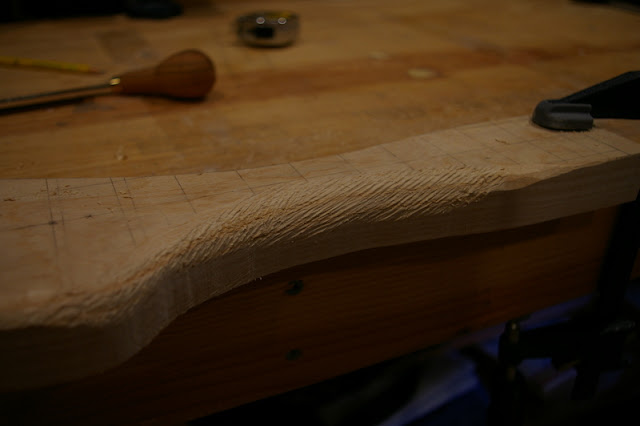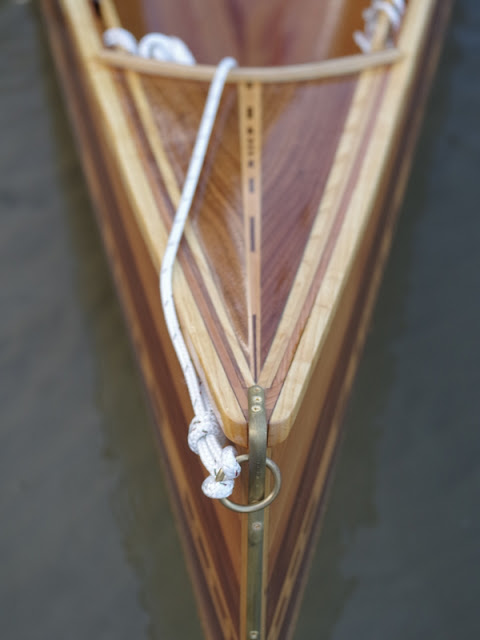Thank you for visiting. For more information, please visit chasenye.com.
I have always thought that making an instrument or a boat might be the ultimate challenges for woodworkers. I don't know if many woodworkers agree with me. But, that's my take on it. Regardless of the caliber of these feats, there is something wonderful about hearing resonance from something that you crafted or gliding across water in a vessel that you saw emerge from a pile of lumber.
Beginning in August of 2011, I embarked on one such voyage. I hoped to craft a canoe in the same manner practiced by master builders over the past 100+ years. The task came with its challenges, and many were caused by my limitations. Some were financial, some were work-space limitations, and the others were humbling skill-based limitations. Despite these limitations, the endeavor was a successful one.
The boat is a Bob's Special designed and sold by Bear Mountain Boats. I spent a total of 280 hands-on hours, and dozens of un-tallied research hours, building a canoe from strips of western red cedar. After one year, the canoe is in the water. I built it in my backyard with consumer-grade tools, and few tasks required more hands than my own. The total cost of the canoe itself was $1533. The cost is inflated by poor estimates of quantity and, at times, a desire to pay higher prices in order to have an item immediately. I have read in several places that $1000 is a normal price. I believe that this is an antiquated and geographically specific sum.
My guide was Canoecraft by Ted Moores at Bear Mountain. I read it front to cover before purchasing a single item. The book provides essential knowledge throughout the process. Other books are available if you plan to cut corners or would like a more regionally specific book to reference (this book is specific to Ontairo). Be creative in your resources, but if you are looking for the best, look no further. Canoecraft is your new bible.
Canoe Materials |
Cost |
| Plans for the Bob's Special | $100 |
| Lumber for strongback and forms | $167 |
| 3-Gallon epoxy resin kit | $200 |
| White ash for the stems | $10 |
| 7 - 2x4" boards of western red cedar ranging from 16 to 19 feet | $525 |
| Walnut and beech for the feature plank | $49 |
| 12 yards of 7 ounce fiberglass | $110 |
| White ash for trim | $110 |
| White ash for paddles | $55 |
| Rattan cane for seats | $17 |
| 1 gallon of tung oil varnish | $110 |
| 6 feet of brass stem band | $40 |
| Bronze carriage bolts | $30 |
| Brass Screws | $10 |
That is the essential preamble to this photographic account of a cedar strip canoe build. The following is the story of my boat, built over the 2011-2012 school year. It is not a detailed nor a tutorial account. It is meant to be a light reference for like endeavors. Enjoy.
Overview
To begin, here is an overview of the finished product out on its first voyage. The good news is that it floats.
The boat is 15 feet of Western Red Cedar. The feature plank on the hull incorporates walnut and beech. The decks are comprised of walnut. Gunwales are ash and walnut. The thwart, seats, and paddles are ash.
The trim is copper, bronze and brass.
The walnut/beech pattern found in the feature was carried throughout the boat and paddles.
The pattern in the seat is simply a traditional weave stopped short and well thought out in order.
The thwart was hand-carved using quarter round rasps and a draw knife.
Paddles were fitted to their owners.
Copper tubing with two coats of varnish provide spacing for the seat hangers. Seats were made of ash and a natural rettan cane.
Weighing in at an approximate weight of 55 lbs., she rides slow... and slow is smooth... and smooth is fast.
Laying Up a Form on which to build (13 hours)
I built a 15-foot Bob's Special. I purchased plans from Bear Mountain. They came with a detailed pamphlet highlighting the essential techniques found in Canoecraft.
To build the strongback, I used 3/4-inch plywood with hopes of boats in the future.
The strongback emerges from a pile of lumber. All plans are found in Canoecraft.
Ensuring that the strongback is straight and level is essential. This will be the home for my boat for one full year... rain or shine.
I used carbon paper to transfer the shapes of each station form.
Here are the forms all transferred and waiting to be cut.
Using a jig-saw, I made mistakes requiring some body filler.
A string down the center provides a great guide for each form.
All forms lined up, the shape emerges.
Numerous jigs were required before beginning with the planking.
The jigs were essential because I chose to use a method of zero staples. It adds a nice challenge to the process.
Finally, I made a series of wedges.
Steam-bending The Stems (12 hours)
Steaming the wood is rare on this project. This is one of two tasks that required steaming.
I simply connected a fuel line to a pressure cooker and ran the line to a PVC pipe.
After steaming I quickly clamped them to the form.
Here is the stem with the form back on the strongback.
Machining The Strips (20 hours)
Machining the strips is the biggest operation. You may choose to purchase them cut. This will cost you about 100% more if you are purchasing the wood from a region foreign to red or white cedar.
A series of jigs were used to hold the 2x4's in place as they passed through the saw.
This was one of the few 2-person jobs.
Finally, getting an idea of the coloring options. Note the different lengths. Lumber in this quality is limited in central Texas.
After ripping the boards twice, we routed each edge. One with a bead and one with a cove.
A finished product. I had a lot of extra planks. This is where some of my wasted cost went. I possessed about $280 of unneeded wood.
Stored in a handy location for planking.
Planking The Hull (74 hours)
Setting up the first plank is crucial, but easy.
Here you can see the series of jigs and wedges that I used to clamp each plank. Due to the relative weakness of the spring clamps and the challenges of working with the cedar strips, I decided to place one at a time. Ted Moores recommends doing 3 at a time. I never quite got that down.
Using strips from a darker piece of cedar, I created a dramatic feature that will sit well above the water line.
Late in the game I decided to include a feature plank of contrasting woods. I used walnut and beech. I would have preferred basswood over beech, for it it much softer, but basswood of an appropriate size was not available.
Getting the grain ultimately running in the correct direction required many steps. I glued 3 walnut boards together via an edge joint, and did the same with the beech. Afterwards, I crosscut them to progressively larger widths. Finally, I alternately glued them together from thinnest (in the middle) to widest (at the ends).
Afterwards, I planed down one side.
I then cut strips and ripped them to 5/8 inch. After all of the cutting and gluing, I had alternating strips with the grain running in the appropriate direction.
In the end, I had 24-inch strips. I glued them together to make longer strips by using a diamond shaped piece of beech set in the two walnut ends.
In order to separate the walnut from the darker cedar, I used a 1/4-inch piece of beech trip. I added a bead to one side to match the coved edge of the cedar below.
After gluing the lengths together, I was forced to break some apart, as they were not flexible enough to make the complex bends of the hull.
Moving forward after a lengthy feature plank.
Moving from the feature plank to the bilge was quick.
The bilge required creativity in order to apply sufficient pressure.
I switched to a series of tie-downs to get the correct pressure at the water line. This helped to pull the two sides of the hull together as they met at the bow and stern.
Closing the hull goes one side at a time.
Once one side is in place, I chiseled a straight line down the center to make room for the stripping on the other side. From here on all strips were cut and planed to fit a specific length and shape.
Last piece cut and ready to go in.
I then added the shorter pieces at bow and stern.
What we saw before was the inner stem. Here is the outer stem being test fitted.
A final look at the hull.
Fairing The Hull (25 hours)
Here is a look at trimming the sheer line. I used a piece of cedar batten that fell to a natural curve.
A block plane and a spokeshave did most of the hard work.
Here is the stem in place and shaved down to match the contour of the hull.
Of course a healthy pile of shavings was left over after fairing the outside of the hull.
Laying Up The Fiberglass (13 hours)
A significant amount of sanding was completed between fairing and lay up.
All hands were on deck for the task.
After the first coat

I applied 2 coats of epoxy over the initial epoxy/glass coat. I wasn't pleased with the finish after 3 coats. So I sanded down the third coat and applied a fourth.
After the fourth coat, I was pleased with the finish.
Fairing The Inside of The Hull (20 hours)
I removed all of the form stations excluding the stem stations.
With the stem stations attached I turned the hull and saw her right-side-up for the first time. Also, note that I sanded the outside of the hull prior to removing it from mold.
Fairing the inside of the hull required excessive use of a scraper.
Inside Layup (5 hours)
Laying up the inside was more challenging than the outside. Keeping the glass down took a lot of work and I wasn't completely successful. In the end I had to make some repairs along the sheer line.
It's essential that the hull doesn't heat up too much while the inside epoxy is setting up. We moved the hull inside to avoid such risk.
Machining The Gunwales (20 hours)
Pictures of the gunwales are scarce for some reason. This is an image of a sliding jig that I had to make for the table saw in order to make accurate and consistent angled cuts. The outer gunwales are solid ash while the inner gunwales are ash with walnut spacers that create scuppers for proper drainage.
Machining The Decks (14 hours)
In order to create a vanishing line on the decks (which adds to the elegance of the boats lines), I cut a piece of walnut diagonally and flipped one side 180 degrees and transferred it across its mate. That sounds confusing, but basically you cut the board diagonally and then line up the two triangles so that the grain is vanishing toward the points.
I then added beech and some remnants from the feature plank to carry the feature through the rest of the boat. After gluing each piece on the the deck, I planed it to 1/16 of an inch at the deck's point. Again, this added to the vanishing point.
Here is a look at the lines and grain pattern at the deck's point.
I wanted to add a coaming to the deck to provide a nautical feeling to the boat. This was the other item that required steam bending the wood. I made an arched 3-ply with ash and a walnut core.

I used the deck itself to glue the ply so that it would hold the exact shape necessary.
The decks are my favorite part of the boat. As they should be.
Machining The Seats (26 hours)

Making the seats themselves was fairly straight forward. Getting the angles was the challenge. The extra seat is a result of poor measurements.
The seats are a little tricky to hang perfectly level. I followed Moores instructions to the best of my ability. The result was not an exact copy but a success.
I tried making ash barrels to create spacers. I struggled to make eight spacers line up well.
I then opted for copper. I added a layer of Varnish to prevent corrosion.
I threw down some rattan with a simple weave.
I used a traditional weave pattern found on most kitchen chairs, but stopped the diagonals short of completion to add a more deliberate diagonal pattern.
Carving The Thwart (7 hours)
The thwart was carved out of 1 and a 1/4 inch ash.
I cut it out with a jig saw...
... then used a draw knife to get it started and then put some force behind a quarter-round rasp to finish it up.
A space for the seventh vertebrae.
The end of the thwart was split so I attached a perpendicular length of wood with epoxy to add strength.
Covered in 3 coats of varnish.
Paddles (13 hours)
The paddles started as enormous pieces of ash. If you're wondering why so much ash, it's because it has a great strength to weight ratio, is readily available, and is affordable.
I ripped each board in two and added the walnut beech pattern from the hull.
I researched traditional paddle shapes and found a great resource here. On his page you can find numerous paddles and paddle stories as well as step-by-step instruction on making paddles with hand tools. I opted for an ottertail shape that will favor longer trips in exchange for less maneuverability in short distances.
Cutting the paddles out by hand was easier than using a jig saw. Although, I used a jigsaw for curves.
I planed each side down to the thinnest I dared.
Varnish (18 hours)
Adding the varnish was one of the most challenging tasks. That is because it was the last task and arguably the most visible. My challenges were caused mostly by applying the varnish in outside. The heat and dust added to the challenge.
Sanding down the varnish between coats.
I had just applied a great final coat when a bird mysteriously flew into the wet tung oil. Frustrated, to say the least, I sanded it down and applied another two coats.
On the water
Ready to roll, we loaded her up and headed to Lake Austin.











